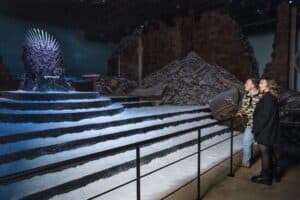Hallowe’en is derived from the ancient Celtic festival of Samhain (pronounced sow-in, with sow pronounced like the female . You know it’s a good Irish word when there are two levels to the pronunciation explanation). To understand pagan festivals, you first need to put yourself in their shoes. Like most other people of the time, they literally lived and died by the weather. It is for this reason sun-worship was a thing and the reason why every conversation with an Irish person still starts with small-talk about the weather. The Samhain festival was the end of their summer and the beginning of a cold, dark winter they spent all year preparing for. Despite this, many would die and Samhain was a way to acknowledge this and celebrate all those they lost in the previous year.
The Bonfire
Hallowe’en was the day of the year where the boundaries between the living world and the Otherworld were less secure. It was believed that those in the spirit world could cross over freely on this night. To ward off the evil among them, huge bonfires were lit, and crops and animals were burned as sacrifices to the Celtic deities. When the celebrations ended but the bonfire still burned bright, many people re-lit their own fires from the sacred bonfire as a way to get a piece of the protection offered from these sacrifices.
Bobbing for Apples
 The inclusion of apples during Hallowe’en had a lot to do with matchmaking. A young woman would toss apple-peels over their shoulders in the hope that the peel would land on the ground to form the initials of her future husband. Another ritual at parties was apple bobbing, which is still common today. The first to take a bite out of an apple would be the first to get married. There were other equally-as-strange rituals that haven’t made it to the present day, including looking at egg yolks floating in a bowl of water to discern their futures, or standing in front of mirrors in darkened rooms and looking over their shoulders for their husbands’ faces through the candle light.
The inclusion of apples during Hallowe’en had a lot to do with matchmaking. A young woman would toss apple-peels over their shoulders in the hope that the peel would land on the ground to form the initials of her future husband. Another ritual at parties was apple bobbing, which is still common today. The first to take a bite out of an apple would be the first to get married. There were other equally-as-strange rituals that haven’t made it to the present day, including looking at egg yolks floating in a bowl of water to discern their futures, or standing in front of mirrors in darkened rooms and looking over their shoulders for their husbands’ faces through the candle light.
Dressing Up in Costume & Mask
The bonfire was there to ward off evil spirits, but what if some of them made it through and wished to exact revenge on those who had wronged them in their lifetime? Many people dressed in disguises so as not to be judged for their past misdeeds. These disguises or costumes were generally animal heads and/or skins. That means no sexy nurses but a lazy attempt at a cat costume (headband with ears and sharpied cheeks) would probably not have been too out of place. I’m not sure it would have fooled a particularly venomous Banshee, however!
Jack-o-Lanterns
 I bought vegetables at two different Market Basket locations this year – this sounds extremely impertinent but bear with me – and both times the cashier had to ask me what one particular vegetable was. It was a turnip. I had turnips for dinner all the time growing up in Ireland. I didn’t say I ate them but they were on the plate. During the Samhain festival, the ancient Irish carved out turnips with monstrous visages to serve as lanterns that would ward off the aforementioned evil spirits – a bit like a scarecrow, except more grotesque, on fire, and used to intimidate other-worldly ghosts rather than food-stealing birds. Scots-Irish immigrants carried this tradition with them to the US and adapted to use pumpkins as turnips were more difficult to find*. Should have gone to Market Basket!
I bought vegetables at two different Market Basket locations this year – this sounds extremely impertinent but bear with me – and both times the cashier had to ask me what one particular vegetable was. It was a turnip. I had turnips for dinner all the time growing up in Ireland. I didn’t say I ate them but they were on the plate. During the Samhain festival, the ancient Irish carved out turnips with monstrous visages to serve as lanterns that would ward off the aforementioned evil spirits – a bit like a scarecrow, except more grotesque, on fire, and used to intimidate other-worldly ghosts rather than food-stealing birds. Scots-Irish immigrants carried this tradition with them to the US and adapted to use pumpkins as turnips were more difficult to find*. Should have gone to Market Basket!
Trick or Treating
Like everything else here, trick-or-treating does have some roots in the festival of Samhain, but that doesn’t mean that children went door to door, dressed in trash bags (is this just an Irish thing?), and asking their neighbors for candy. As mentioned above, many dressed up in costume to disguise themselves from enemy spirits. This developed over the centuries where some entrepreneurial individuals dressed up as demons and ghosts, and performed antics or tricks in exchange for food and drink. With the spread of Christianity and the blending of older pagan rituals with newer Christian ones, poorer people took to visiting the houses of the wealthy and received food in exchange for the promise to pray for the souls of their dead. Children in Ireland and Scotland saw an opportunity for themselves and this developed into something closer to the type of trick-or-treating we know today.
HAPPY HALLOWE’EN!
Bonus Treats
Hallowe’en traditions aren’t the only things that are commonplace nowadays but find their roots in ancient times –
the names of the days of the week and months of the year – for example, Wednesday is named for the Norse god Odin, or Woden, and Thursday for his son, Thor.
knocking on wood – the Celts believed there were spirits in trees and knocking on, or touching, them brought healing and protection.
covering your mouth when yawning – in the age of Covid, this is more than just a way of protecting strangers from seeing your tonsils. In ancient Rome, it was a way of preventing a demon or evil spirit from entering your body and making you sick, especially since yawning is contagious.
cat obsession – pagans believed cats (and other animals) to be inhabited by fairies, making them a link to the supernatural world – and this was before laser pointers were a thing! With the spread of Christianity, cats took on a more negative connotation, and were seen of bad omens and associated with witches.
*This wasn’t the only adaption of Irish traditions to the US. For example, almost no one in Ireland eats corned beef.





